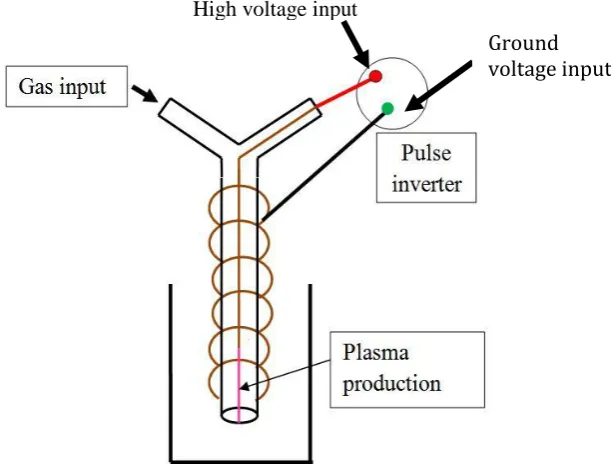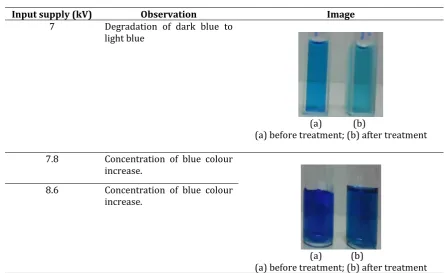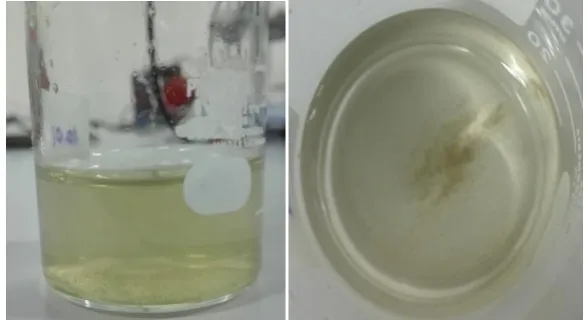Preliminary Analysis of the Degradation of Methylene Blue by Using
Plasma Discharge in Liquid
N. A. H. Ramli1, 2, SK Zaaba1, 2*, MT Mustaffa3, Khairunizam WAN1 and Shahriman AB1
1School of Mechatronic Engineering, Universiti Malaysia Perlis, Kampus Pauh Putra, 02600 Arau, Perlis,
Malaysia.
2Centre of Excellence for Advanced Sensor Technology (CEASTech), Universiti Malaysia Perlis. 3
School of Manufacturing Engineering, Universiti Malaysia Perlis, Kampus Pauh Putra,02600 Arau, Perlis, Malaysia.
ABSTRACT
This article presents the results of experimental work on the identification of reactive species produced by plasma discharge in liquid. The analysis was conducted using methylene blue (MB) as chemical probe. There are two objectives, 1) to identify the effect of ground electrode configuration to the presence of reactive species and 2) to observe the ground electrode durability. Results showed that, degradation of MB occurred when using 7 kV input supply and insulated ground electrode for 10 minutes. Meanwhile, the other input supply (7.8 kV and 8.6 kV) were unable to degrade MB solution.
Keywords: Plasma Liquid, Insulated Ground Electrode, Methylene Blue (MB), Reactive Species, Helium Plasma, Surface Discharge.
1. INTRODUCTION
Plasma discharge in liquid is widely studied because it has the potential to be applied in numerous applications, including material processing, water purification, and sterilization [1]. The main advantage of plasma discharge in liquid is, it can generate chemical species which will penetrate into the liquid surface. This penetration will lead to the initiation of chemical and biocidal processes inside the liquid solution [2]. There are two main chemical species produced by plasma treatment which are Reactive Oxygen Species (ROS) and Reactive Nitrogen Species (RNS)[3]. Hydroxyl ion is one of an example of ROS. It has strong oxidation potential compared to other ROS. Unfortunately, hydroxyl has short lifetime. Overcoming these challenges will lead to the potential use of OH radicals in a wide range of application. Hence, plasma discharge in liquid was proposed in order to overcome this issue. By developing plasma discharge in liquid device, an abundant source of OH radical can be generated [4].
In order to develop plasma discharge in liquid device, there are a few main elements that need to be considered, namely input sources, dielectric barrier, reactive species production and also durability of electrode material [5]. For this experiment, it will be focusing on two objectives. The first one is to investigate the effect of different ground electrode configuration to the presence of reactive species. For this test, two types of electrode configuration were used namely insulated and non-insulated ground electrode. Then, the value of input supply will be varied and the existence of reactive species inside the plasma treated liquid will be detected by using chemical probe. This was chosen because it is the simplest method that can be used to detect reactive species inside aqueous solution [6]. For
8
chemical probe, each type of reagent will give different effect to the different types of radical formed. In this test, chemical probe that will be used is methylene blue (MB). In MB cases, it will turn colourless if there is the presence of hydroxyl radical inside the solution [7]–[9]. Meanwhile, the second objective is to investigate the durability of the ground electrode. The durability test will be conducted by observing physical changes of the ground electrode after plasma treatment.
2. EXPERIMENTAL WORK AND APPARATUS
Plasma discharge in liquid device consists of pulse inverter, power supply, quartz glass, gas supply, high voltage and ground electrode [10]. The device configuration is as shown in figure 1. The device consists of 60 mm long cylindrical quartz glass tube with an inner diameter 2mm and outer diameter 4.5mm. High voltage electrode is located inside the quartz glass; meanwhile the ground electrode is wounded outside the quartz glass.
2.1 Material
Material used in this analysis is methylene blue (MB) and distilled water. Distilled water was used to dilute MB. Meanwhile, MB reacts as a chemical probe to detect hydroxyl radical.
Figure 1. Plasma discharge in liquid device.
2.2 Part 1: Effect of Different Ground Electrode Configuration to the Presence of Hydroxyl Radical inside Plasma Treated Liquid
The objective of this experiment is to investigate the effect of different ground electrode to the production of reactive species inside the plasma treated liquid. There are two types of ground electrode configuration used in this test namely insulated and non-insulated ground electrode. Then, the value of input source will be varied during the test which is 7 kV, 7.8 kV, and 8.6 kV. The flow rate of gas and treatment time was fixed through the experiment which is 450ml/min and 10 minutes respectively. Meanwhile, type of gas used in this experiment is helium. Helium was chosen because it has the highest ionization energy compared to other inert gases[11].
High voltage input
9 The existence of hydroxyl radical inside plasma treated liquid will be detected by observing the concentration of MB colour before and after the treatment. Following this result, it will be further established by conducting UV-Vis analysis. The UV-Vis spectrometer was used to detect the concentration of methylene blue by comparing the absorbance value of solution before and after treatment [12]. By obtaining the absorbance value, the increment or degradation value of methylene blue can be obtained. In MB cases, it will turn colourless after plasma discharge if there is any hydroxyl radical inside the solution [7]–[9].
2.3 Part 2: Ground Electrode Durability Test
For this part, the durability of electrode will be examined by observing the physical changes of the ground copper electrode before and after the treatment. There are two configurations of ground electrode that was tested namely insulated ground electrode and non-insulated ground electrode as shown in figure 2. The insulator used for this test is Kapton tape. Kapton tape was chosen as the insulator because it has the advantage to be used at high temperature and has the ability to withstand flame, chemical and radiation resistant[13]. Material used as the electrode is copper wire. For this test, the solution used is distilled water and the time treatment is 10 minute. Meanwhile, the working gas and flow rate used are helium and 450 ml/min respectively. Volume of distilled water is 20ml.
Figure 2. Ground electrode; 2(i) insulated ground electrode, 2(ii) non-insulated ground electrode.
10
3. RESULT AND DISCUSSION
This section describes results from the effect of different ground electrode configuration to the presence of hydroxyl radical inside plasma treated liquid. Statistical data by using SSPS software are also included to show the correlation between concentration of MB before and after the treatment. The last part is the discussion on the durability test of ground electrode.
3.1 Effect of Different Ground Electrode Configuration to the Presence of Hydroxyl Radical Inside Plasma Treated Liquid
Previous research stated that plasma was able to degrade MB from dark blue colour to colourless [14]. Unfortunately, this device is unable to degrade MB thoroughly. The results are shown in table 1 and table 2. This observation was conducted by naked eye. Meanwhile, UV-Vis Spectrometer was used in order to detect the absorbance value of the solution before and after the treatment. By obtaining the absorbance value, the concentration changes of the liquid can be detected. It is because the absorption value of UV-Vis spectrometer is depend on the colour of the chemical involved during the measurement. Hence, the higher the colour of the liquid sample, the higher the absorbance value. The absorption of MB is in the range of 600-700 nm.
Table 1 shows MB concentration results for non-insulated ground electrode. Non-insulated ground electrode is unable to degrade MB solution. Although, three varied input voltage was used, the device were still unable to degrade the MB solution. In contrast, the concentration of MB solution increased after the treatment. It is shown in table 1, the MB colour is darker after the treatment. In order to analyse these changes, UV-Vis analysis was conducted. Based on figure 3, it shows that all the absorbance spectra recorded after treatment is more than before treatment. This shows that there are increments of the concentration of the liquid after treatment.
Table 2 shows the results for insulated ground electrode. There is slightly a change of colour after plasma liquid treatment by using input supply of 7 kV. After the treatment, the colour changes from dark blue to light blue. Meanwhile, for input supply of 7.8 kV and 8.6 kV, there are slightly increase in the colour concentration. After the treatment, The MB solution became darker. Based on figure 4, it shows that the absorbance value for 7 kV is slightly lower compare to the untreated MB solution. Meanwhile, the other two input voltages absorb more colours compared to the untreated solution. Although, it is only slightly different in colour after the treatment, it shows that this device is able to produce hydroxyl radical at 7 kV when using insulated ground electrode in a minimum flow rate of gas which is 450ml/min and 10 minute treatment time.
11
Table 1 Observation of color changes after plasma treatment (Non-insulated ground electrode)
Input supply (kV) Observation Image
7 Concentration of blue colour increased
(a) (b)
(a) before treatment; (b) after treatment 7.8 Concentration of blue colour
increased
8.6 Concentration of blue colour increased
Table 2 Observation of color changes after plasma treatment (Insulated ground electrode)
Input supply (kV) Observation Image
7 Degradation of dark blue to light blue
(a) (b)
(a) before treatment; (b) after treatment
7.8 Concentration of blue colour increase.
(a) (b)
(a) before treatment; (b) after treatment 8.6 Concentration of blue colour
12
Figure 3. Absorbance spectra for non-insulated ground electrode.
Figure 4. Absorbance spectra for insulated ground electrode.
3.2 Statistical Analysis
This part discusses the statistical analysis using SPSS software version 2017. As mention above, UV-Vis spectrometer was used to analyze the concentration of MB before and after the treatment. Hence, the Pearson’s correlation coefficient was conducted to identify the correlation between two variables which is concentration of solution before and after plasma treatment. The size of correlation and its relationship can be referred in table 1.
There are 3 value of input supply used in this test which is 7 kV, 7.8 kV and 8.6 kV. For non-insulated ground electrode, it shows that 7 kV had the weak relationship which means it has a slight difference in the concentration of MB before and after treatment. Meanwhile, 7.8 kV and 8.6 kVhas weak or almost no relationship which means there is no significant difference for the concentration after treatment.
13 expected to occur because; the higher the voltage value, the solution temperature will be higher for insulated ground electrode. The higher the temperature of solution, the lower the production of reactive species [15,16].
Table 3 Coefficient General Interpretation (Line of Best Fit Method)
Size of the correlation General Interpretation of Coefficient
0.8 to 1.0 Very strong relationship
0.6 to 0.8 Strong relationship
0.4 to 0.6 Moderate relationship
0.2 to 0.4 Weak relationship
0.0 to 0.2 Weak or no relationship
Table 4 Correlation between absorbance value for 7 kV, 7.8 kV, 8.6 kV before and after treatment (non-insulate electrode)
Control variables Size of the correlation
Non_ ins_ control 7 kV 7.8 kV 8.6 kV
1.000 0.211 0.163 0.175
Table 5 Correlation between absorbance value for 7 kV, 7.8 kV, 8.6 kV before and after treatment (insulated electrode)
Control variables Size of the correlation
Ins_ control 7 kV 7.8 kV 8.6 kV
1.000 0.501 -0.186 -0.113
3.3 Ground Electrode Durability Test
This test was conducted by using distilled water in order to identify the most durable ground electrode for plasma device by observing the colour and physical changes of the electrode. The input supply used in this test is 7 kV and the time treatment is 10 minute. For non-insulated ground electrode, after 10 minutes it shows that there is dust particles inside the plasma treated liquid (Figure 5). The dust particles detached from the copper electrode during the treatment process. Besides, it also changes the colour of distilled water from white to cloudy.
In the meantime, there is no change of colour and any dust particles found inside the plasma treated liquid from insulated ground electrode.
Figure 5. Plasma treated liquid (Non-insulated).
side view top view
14
4. CONCLUSION
This device is able to change the MB colour slightly with the used of 7 kV input supply and insulated ground electrode. Meanwhile, for 7.8 kV and 8.6 kV input supply, colour pigment of the MB has increased. This result can be correlated with the result obtained from the analysis of absorbance value by using SSPS software. From this result, it shows that the highest absorbance value is recorded when using 7 kV input supply and insulated ground electrode. Meanwhile, there is no different of absorbance value is obtained when using 7.8 kV and 8.6 kV input supply. It shows that there is the presence on reactive species in plasma treated liquid when using 7 kV input supply. In the meantime, the results showed that 7.8 kV and 8.6 kV input supply were unable to produce any reactive species inside plasma treated liquid.
Besides, its shows that the insulated electrode is more durable than non-insulated electrode. The non-insulated electrode rust faster than the insulated. After 10 minute treatment, it shows that the copper electrode degrade during the treatment.
For the future recommendation, it is suggested to vary treatment time and flow rate of gas in order to obtain higher reactive species volume inside the plasma treated liquid. The suggested input voltage that will be used for this device is 7 kV and the suggested electrode used is insulated ground electrode.
ACKNOWLEDGMENT
The author would like to acknowledge the support from the Fundamental Research Grant Scheme (FRGS) under grant number FRGS/1/2015/SG02/UNIMAP/02/5 from the Ministry of Higher Education Malaysia.
REFERENCES
[1] B. R. Locke, “Environmental Applications of Electrical Discharge Plasma with Liquid Water -- A Mini Review --”, (1950) 194–203.
[2] P. Lukes, E. Dolezalova, I. Sisrova, and M. Clupek, “Aqueous-phase chemistry and bactericidal effects from an air discharge plasma in contact with water: evidence for the formation of peroxynitrite through a pseudo-second-order post-discharge reaction of H 2 O 2 and HNO 2”. Plasma Sources Sci. Technol 23, 1 (2014) 15019.
[3] M. Naïtali, G. Kamgang-Youbi, J.-M. Herry, M.-N. Bellon-Fontaine, and J.-L. Brisset, “Combined effects of long-living chemical species during microbial inactivation using atmospheric plasma-treated water”. Appl. Environ. Microbiol 76, 22 (2010) 7662–7664. [4] S. Imai, H. Kumagai, M. Iwata, M. Onodera, and M. Suzuki, “In-Water Plasma Generation on
a Liquid Wall Using a Compact Device and Dedicated Power Supply”. 43, 7 (2015) 1–8. [5] N. A. H. Ramli, S. K. Zaaba, M. T. Mustaffa, A. Zakaria, and S. A. B., “Review on the
development of plasma discharge in liquid solution” (2017) 30015.
[6] A. Khlyustova and N. Khomyakova, “The Effect of pH on OH Radical Generation in Aqueous Solutions by Atmospheric Pressure Glow Discharge”. Plasma Chem. Plasma Process, 2016. [7] K. Hsieh, H. Wang, and B. R. Locke, “Analysis of a gas-liquid film plasma reactor for organic
compound oxidation”. J. Hazard. Mater, 317 (2017) 188–197.
[8] P. Sunka, V. Babicky, M. Clupek, M. Fuciman, P. Lukes, M. Simek, J. Benes, B. Locke, and Z. Majcherova, “Potential applications of pulse electrical discharges in water”. Acta Phys. Slovaca, 54, 2 (2004) 135–145.
15 [10] N. A. H. Ramli, S. K. Zaaba, A. Zakaria, S. M. Mamduh, and N. Albatyiah, “Development of
Atmospheric Plasma Gas Discharge in Liquid” (2014).
[11] J. Jonkers, M. Van De Sande, A. Sola, A. Gamero, and J. Van Der Mullen, “On the differences between ionizing helium and argon plasmas at atmospheric pressure” 30 (2003).
[12] G. Langergraber, N. Fleischmann, F. Hofstaedter, A. Weingartner, and W. Lettle, “Detection of (unusual) changes in wastewater composition using UV/VIS spectroscopy,” Wastewater (2003) 1–8.
[13] E. M. S. Division, “3M TM Polyimide Film Tape 5413” (2010) September.
[14] T. Shibata and H. Nishiyama, “Decomposition of Organic Compounds in Water Using Mist Flow Plasma Reactor”. 6, 3 (2012) 253–259.
[15] S. M. Thagard, K. Takashima, and a. Mizuno, “Chemistry of the positive and negative electrical discharges formed in liquid water and above a gas-liquid surface”. Plasma Chem. Plasma Process. 29, 6 (2009) 455–473.




